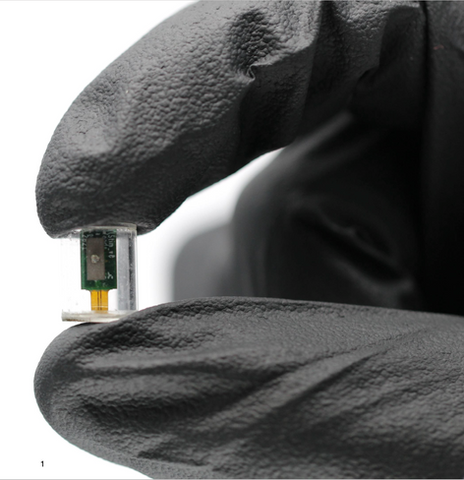top of page
Current Research

Next-gen Brain-Computer Interfaces
Research: Research
Next-generation brain-computer interfaces (BCIs) will transform the treatment of neurological and psychiatric conditions by directly measuring and regulating brain activity. Using advances in materials science and engineering we are building smaller, less invasive BCIs. Much of our work is based on magnetoelectric materials that facilitate efficient wireless power transfer and data communication to miniature implants. Based on these innovations we are building miniature brain stimulators, and networks of distributed implants to record and regulate brain states as therapies for brain conditions that are not responsive to traditional medications.
Select Publications:
"Endocisternal interfaces for minimally invasive neural stimulation and recording of the brain and spinal cord", J. C. Chen, A. Dhuliyawalla, R. Garcia, A. Robledo, J. E. Woods, F. Alrashdan, S. O'Leary, A. Husain, A. Price, S. Crosby, M. M. Felicella, A. K. Wakhloo, P. Karas, N. Provenza, W. Goodman, Sa. A. Sheth, Su. A. Sheth, J. T. Robinson, and P. Kan, Nature Biomedical Engineering, (2024). [web]
"Miniature battery-free epidural cortical stimulators," J. Woods, A. Singer, F. Alrashdan, W. Tan, C. Tan, Su. A. Sheth, Sa. A. Sheth, and J. T. Robinson, Science Advances, (2024). [web]

Translational Bioelectronics
Research: Research
Unlike pharmaceutical therapies that distribute small molecules to the entire body, bioelectronic devices can sense and stimulate activity in select nerves or brain regions to improve therapeutic precision and reduce side effects. To create tiny, wireless versions of bioelectronic devices we use magnetoelectric technologies that harvest power and data from magnetic fields that can penetrate deep into the body. Based on these technologies we are developing implantable networks of miniature devices that can support therapies including non-addictive treatments for pain, and less invasive cardiac pacemakers.
We are also creating "hybrid bioelectronics" that combine the precision of electronic control systems with engineered cells that can produce chemical therapeutic biomolecules. By combining synthetic biology and bioelectronics we are creating improved therapies for cancer, obesity, and women's health.
Select publications:
"Miniature battery-free bioelectronics," V. Nair, A. N. Dalrymple, Z. Yu, G. Balakrishnan, C. J. Bettinger, D. J. Weber, K. Yang, and J. T. Robinson, Science, (2023). [web]
"Self-rectifying magnetoelectric materials for remote neural stimulation and motor function restoration," J. C. Chen, G. Bhave, F. Alrashdan, A. Dhuliyawalla, K. J. Hogan, A. G. Mikos, and J. T. Robinson, Nature Materials, (2023). [web]
“A wireless millimetric magnetoelectric implant for the endovascular stimulation of peripheral nerves,” J. C. Chen, P. Kan, Z. Yu, F. Alrashdan, R. Garcia, A. Singer, C. S. Edwin Lai, B. Avants, S. Crosby, M. M. Felicella, A. Robledo, J. D. Hartgerink, S. A. Sheth, K. Yang, J. T. Robinson, accepted, Nature Biomedical Engineering, (2022). [web]
"Wireless Power Delivery Techniques for Miniature Implantable Bioelectronics," A. Singer, J. T. Robinson, Advanced Healthcare Materials, (2021). [web]
"Magnetoelectric materials for miniature, wireless neural stimulation at therapeutic frequencies," A. Wickens, B. W. Avants, N. Verma, E. Lewis, J. C. Chen, A. K. Feldman, S. Dutta, J. Chu, J. O'Malley, M. Beierlein, C. Kemere, J. T. Robinson, Neuron, 107 (4), 631-643. [web]

NeuroAI
Research: Research
Artificial intelligence based on brain and behavior data can help create systems that mimic human and animal intelligence. Large quantities of neural and behavioral data are essential to train these technologies, providing the diverse, high-dimensional datasets needed to reproduce the output of complex biological systems. To this end we are creating scalable neural recording technologies and behavioral tracking pipelines, to collect brain and behavior data across species, enabling cross-species comparisons that can be used to develop neuro-inspired algorithms.
Select Publications:
"Mesoscopic calcium imaging in a head-unrestrained male non-human primate using a lensless microscope," J. Wu, Y. Chen, A. Veeraraghavan, E. Seidemann, and J. T. Robinson, Nature Comm., (2024). [web]
"Functional imaging of non-human primate visual cortex using a miniaturized lensless microscope," J. Wu, Y. Chen, A. Veeraraghavan, E. Seidemann, and J. T. Robinson, Proceedings of SPIE 12365, Neural Imaging and Sensing 2023, March 2023. [web]
"A microfluidic-induced C. elegans sleep state,"D. L Gonzales, J. Zhou, J. T. Robinson, Nature Comm., 10, 5035 (2019). [web]
"Microfluidics for electrophysiology, imaging, and behavioral analysis of hydra," K. Badhiwala, D. L. Gonzales, D. G. Vercosa, B. W. Avants, J. T. Robinson, Lab on a Chip, DOI: 10.1039/C8LC00475G (2018). [web]
“Scalable electrophysiology in intact small animals with nanoscale suspended electrode arrays,” D. L. Gonzales, K. N. Badhiwala, D. G. Vercosa, B. W. Avants, W. Zhong, J. T. Robinson, Nature Nanotech. Vol. 12, 684 (2017). [web]
"Single-Frame 3D Fluorescence Microscopy with Ultra-Miniature Lensless FlatScope," J. K. Adams,V. Boominathan, B. W. Avants, D. G. Vercosa, R. G. Baraniuk, J. T. Robinson, A. Veeraraghavan, Science Advances Vol. 3, e1701548 (2017). [web]
bottom of page










